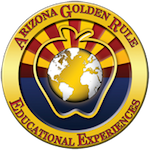A Fair Word: and a Fair Fight
“Governments don’t live together. People live together. Governments don’t always give you a fair word or a fair fight.” This is a movie quote from The Outlaw Josie Wales. Is it an accurate statement of how governments and individuals interact with each other? Can you imagine yourself having a trusting, respectful friendship with someone many people would see as an enemy? Can people treat each other with respect even though their governments are at war?
In 1850, the young United States was embroiled in finding solutions to three problems. The first was maintaining the uneasy balance between the slave states and the free states. Second was overseeing expansion into the Oregon Territory and the new state of California. Access to both areas could be gained by sea, traveling around South America and up the coast. But this was costly and very time-consuming. The third problem was finding a way to use the two huge tracts of land acquired from Mexico, called the Utah and New Mexico Territories. Eventually, one section would become Nevada, Utah and western Colorado. By the early twentieth century, the other would become New Mexico and Arizona. However, the governments involved in these land transfers overlooked the fact that native peoples considered these lands their homelands. This attitude would create terrible difficulties.
For hundreds of years, the Chokonen band of Chiricahua Apaches had roamed the land in what is now northern Mexico and southeastern Arizona. They were a nomadic, hunter-gatherer culture. During the 1850’s, their leader was a man named Cochise. He was respected by his people as a man of honesty, courage, vision, and devotion to his people. Cochise led his band on raids among the Mexican settlers of the area, while having minimal contact with the few Anglos coming through Chiricahua land. There is some evidence that Cochise even supplied firewood to the Butterfield Overland Coach outposts as the coaches made their way through Arizona on the way from Texas to California. A decade later, rash actions by an inexperienced twenty-four year old Army Lieutenant would bring about a dangerous change in Cochise’s attitude toward the Americans in the Apache homeland.
In January of 1861, Indians raided a small ranch, stole some cattle and kidnapped the twelve year old stepson of rancher John Ward. Ward reported this to the local military. Under the assumption that Cochise was responsible, Lieutenant George Bascomb rode with fifty-four cavalry troopers to meet with Cochise at Apache Pass. Cochise came, under a peace banner, to declare his innocence and offered to find the band responsible. Along with Cochise were his wife and young son, his brother and two nephews. Refusing to believe Cochise, Bascomb captured the group and tried to hold them hostage. Cochise cut through a tent and was wounded as he escaped. Days later, he took some Butterfield stage drivers hostage, offering to exchange these hostages for his family. Cavalry Sergeant Reuben Bernard, who had served in the area for two years, advised Bascomb to free the Cochise’s family. Bascomb refused.
Over the next two weeks, the hostages were killed, Cochise’s wife and son were released, but his brother and nephews were hanged by the army. Their bodies were left to rot. The action became known as The Bascomb Incident. This distrust and miscalculation ignited a brutal war that would last eleven years and would cost hundreds of lives. Sergeant Bernard, who would ultimately be promoted to the rank of General, kept a journal during his entire military career. After the Civil War, he had more encounters with Cochise. When asked about his notes regarding the Bascomb Incident, Bernard said, “Cochise was at peace until betrayed and wounded by white men. He, now, when spoken to about peace, points to his scars and says, ‘I was at peace with the whites until they tried to kill me for what other Indians did; I now live and die at war with them’.”
With the onset of the Civil War in April of 1861, the United States military had to focus their actions on enemies closer to home. For over a decade, Cochise would be able to raid and attack white and Mexican settlements with little fear of pursuit. Resolution of the Apache problem would be left until 1872.
During those years, one white man came to Cochise offering him ‘a fair word and a fair fight.’ In 1862, Thomas Jeffords left a small village in western New York to pursue a life-long adventure in the Far West. In Arizona, he served as a scout and wagon driver for the army. This gave him knowledge of the area and the skills needed to become the manager of the Overland mail route in 1866. During the next sixteen months, eleven of his mail riders were killed by Apaches. Jeffords decided to do something to secure the safety of the mail carriers. Alone, he rode unarmed through the Dragoon Mountains to the Chiricahua camp to seek peace. Cochise was impressed by his bravery and realized it would be possible to build a trusting relationship with a white man like Jeffords. Years later, the relationship developed into a friendship and trust that enabled Jeffords to be initiated into the Chiricahua band.
Back in the eastern part of the United States, the recently-elected President Ulysses S. Grant, selected the man he felt could bring peace to Arizona. Because of his devout faith, General Oliver O. Howard was called “the Christian General.” At the end of the Civil War, Grant had assigned Howard to one of the most difficult jobs imaginable. Overseeing the Freedman’s Bureau required Howard to find a way to supply four million freed slaves with necessary food, clothing, and housing. As the former slaves began to take their place in society and pursue the rights of their new freedom, General Howard also had the responsibility to protect them from the groups of white militia determined to terrorize them. Howard decided to lead in the changes that needed to be made in Washington, DC. He integrated his own church and then founded a rigorously academic school for blacks. Today, that school is the prestigious Howard University.
General Oliver Howard was a man who treated others with the respect he wanted for himself. President Grant knew this was the man with the necessary skills, compassion and integrity to negotiate a peace with Cochise.
When Howard reached southern Arizona, he met with Jeffords. Convinced that General Howard would deal honorably with Cochise, Jeffords agreed to take the general and his aide-de-camp, Captain Joseph Alton Sladen, to the Chokonen stronghold and interpret the discussions between the two leaders. They were accompanied by two nephews of Cochise, one of whom was probably the son of the brother who had been killed in the Bascomb Incident. Captain Sladen recorded some impressions of Cochise in his journal. “He carried himself at all times with great dignity, and was treated by those about him with the utmost respect.” General Howard was greatly impressed by Cochises’s skills as a tactician. “No General in the Army of the United States could have made a better placement of his men to resist an attack from a superior force.”
But Cochise did not plan to resist. He knew that making peace was a necessity for the survival of his people. “We were once a numerous tribe, living well and at peace. But my best friends were taken by treachery and murdered,” Cochise said. Through Jeffords, he made clear the two requirements for peace: a reservation there in the Chiricahua homeland with a white man he trusted to serve as their agent. He wanted Jeffords to be that agent. As the representative of the United States, Howard agreed to the terms and peace was sealed.
Cochise was able to enjoy this peace for only a short time. Within two years, the strong leader of the Chiricahua began to weaken. The symptoms of his illness make it likely that he suffered from stomach cancer, an excruciatingly painful illness at a time when pain-killing drugs were not available. During this illness, Jeffords continued to visit and spend time with the friend he greatly admired. In a probable mixture –English, Spanish, and Apache–the two had a serious and honest conversation on June 7, 1874, which Jeffords later related to others. “Do you think you will ever see me alive again?” asked Cochise.
False truths, even comforting ones, were not part of their friendship.
Jeffords replied, “No, I do not think I will. I think that by tomorrow night you will be dead.”
“Yes,” answered Cochise. “I think so, too. About ten o’clock tomorrow morning. Do you think we will ever meet again?”
“I don’t know. What is your opinion about it?”
“I have been thinking a good deal about it while I have been sick here. I believe we will. Good friends will meet again–up there,” Cochise continued, pointing to the sky.
As he predicted, Cochise died about 10:00 the next day. Jeffords helped in the preparations for the burial, which custom required to occur on the same day as the death. Family members washed the great leader’s body and propped it up astride his favorite horse. Tom Jeffords was one of the mourners who led the horse and its load of belongings deep into the sanctuary of the Dragoon Mountains. There, everything would be placed in a well-hidden chasm. This location still remains secret.
After the death of Cochise, mining and ranching interests increased pressure to move the reservation further north. Tom Jeffords was considered too much of an advocate for the Apache to remain as agent. For the forty remaining years of his life, Jeffords lived on a small homestead near Owl Head Buttes in the Tortolita Mountains between Tucson and Tombstone.
In 1886, 500 of the Chiricahua were taken from their homeland and sent by train to St. Augustine, Florida. There they were confined in Fort Marion and the Castillo de San Marcos for the next twenty-eight years. Over 400 of these prisoners were women, children and the elderly. They were allowed to return to Arizona in 1914, the year Tom Jeffords died. Perhaps he and his old friend did meet up in the sky and watch their return.
Sources: “Cochise: Chiricahua Apache Chief,” Edwin R. Sweeney “Making Peace with Cochise: The 1872 Journal of Captain Joseph Alton Sladen,” edited by Edwin R. Sweeney with a foreword by Frank J. Sladen, Jr.
- Cochise was the leader of many savage attacks. Analyze his behavior in relation with following the Golden Rule.
- Respect and fair treatment are essential in negotiating and resolving many difficult interactions. Examine the differences in the meetings between Cochise and Lieutenant Bascomb and Cochise and General Howard. What were the similarities and differences? How did they affect the outcomes?
- RESEARCH: General Howard had another mission among the Nez Perce in the Northwest. He also developed great respect for the leader of that tribe. Find the similarities and differences between that case and his treaty negotiations with Cochise.
- Cochise and Jeffords forged a close friendship despite great cultural barriers. How do you think similar cross-cultural friendships could be formed today? What is their importance?


